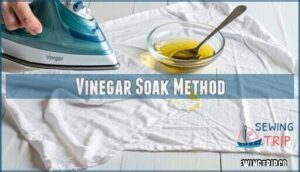This site is supported by our readers. We may earn a commission, at no cost to you, if you purchase through links.

For light scorch marks, try white vinegar or hydrogen peroxide applied directly to the stain, then rinse with cold water.
Water spots usually disappear with a simple rewash using your regular detergent.
For stubborn mineral deposits, create a paste with baking soda and water, let it sit for 30 minutes, then scrub gently before washing.
Steam can also work wonders – hold the garment taut and apply steam from your iron’s vertical setting.
The key is acting fast and matching your method to the specific type of mark you’re dealing with.
Table Of Contents
Key Takeaways
- Act fast when you spot iron marks – immediate action prevents stains from setting permanently, giving you the best chance at complete removal
- Match your removal method to the fabric type – natural fibers, like cotton, handle aggressive treatments better than synthetics, which can suffer irreversible damage from heat
- Start with gentle methods before escalating – try steam or cold water soaks first, then progress to hydrogen peroxide or vinegar if needed
- Prevention beats repair every time – use proper iron temperature settings, pressing cloths on delicate fabrics, and keep your iron moving to avoid future marks
Iron Marks on Clothes
You’ve probably encountered those frustrating shiny marks or scorch stains on your favorite clothes after ironing.
These iron marks happen when heat damages fabric fibers, but the good news is that most can be removed with the right approach.
Identifying Fabric Types
Before tackling iron marks, you need proper fabric identification to choose the right removal method.
Natural fibers like cotton and linen handle high heat better than synthetic fibers such as polyester, which can melt permanently.
Check care labels for fiber content, or perform a simple touch test—natural fibers feel breathable while synthetics feel slicker.
Understanding the fabric types guide is essential for effective ironing and removal of marks, using the right method for your specific fabric type and ensuring you have the right removal method.
Causes of Iron Marks
When you crank up your iron’s heat too high, you’re setting yourself up for fabric damage and unwanted iron marks.
High iron temperature causes fiber compression, leading to those dreaded shiny spots and burn marks on your favorite clothes.
Here’s what causes iron marks:
- Excessive heat melts synthetic fibers and scorches natural materials
- Prolonged contact compresses fibers, creating permanent shine spots
- Dirty iron plates transfer rust and residue, leaving dark streaks
Understanding these culprits helps you master scorch prevention and avoid costly mistakes during your next ironing session.
Prevention Methods
Prevention beats fixing iron marks every time.
Set your iron to match fabric labels – cotton needs high heat, polyester requires low temperatures.
Clean your iron’s steam reservoir monthly to prevent rust flakes.
Use pressing cloths on delicate materials and keep the iron moving to avoid prolonged contact.
Proper fabric prep and heat control save your clothes from permanent damage.
Remove Iron Marks Easily
With proper fabric care and iron safety practices, you can successfully tackle iron marks without damaging your garments further.
The key to effective mark removal lies in acting quickly and choosing the right approach for your specific fabric type. Different materials respond better to certain stain prevention and laundry tips techniques.
Before attempting to remove iron marks, consider these essential factors:
- Fabric identification – Natural fibers like cotton and wool have better recovery chances than synthetic materials
- Mark severity – Light scorch marks respond better to treatment than deep burns or melted fibers
- Immediate action – Quick response prevents marks from setting permanently into fabric fibers
Understanding your fabric’s composition determines whether you can remove iron stains completely or just minimize their appearance. Synthetic fabrics like polyester often suffer irreversible damage when exposed to excessive heat, making iron stain removal more challenging.
Natural fibers generally offer more hope for successful scorch mark removal through various proven techniques. Mastering proper pressing techniques is vital to prevent iron marks from occurring in the first place.
Steam Removal Techniques
Steam offers the gentlest approach to removing iron marks without risking additional fabric damage.
You can use your iron’s vertical steam feature, try a cold water overnight soak, or apply a vinegar solution to restore your garment’s original appearance, using a method that is gentle and effective.
Vertical Steam Feature
Your steam iron’s vertical steam feature works like magic for removing iron marks.
Hang the garment and hold your steam iron upright, directing steam at the shiny area from about one inch away.
The high-pressure steam loosens compressed fibers without touching the fabric.
Move slowly across the mark for 30-60 seconds, then brush gently with a clean towel.
Understanding iron marks removal techniques is essential for effectively treating damaged fabrics with the help of vertical steam.
Cold Water Plunge
Sometimes a gentler approach works wonders for stubborn iron marks.
The cold water plunge method uses fiber relaxation to restore your fabric’s natural texture. This technique helps soften flattened fibers through extended water temperature exposure, making mark removal more effective.
Here’s your cold water plunge process:
- Submerge the garment completely in cold water overnight
- Gently agitate the fabric to encourage fiber movement
- Remove and assess the mark’s visibility before proceeding
This fabric soaking method works particularly well on natural fibers like cotton and wool, where compressed fibers can return to their original state with patience.
Vinegar Soak Method
Mix two parts water with one part white vinegar for effective vinegar application and fabric restoration.
Dab this natural remedy onto iron marks using a clean cloth, then alternate with a water-dampened cloth.
This soak technique helps restore fibers to their natural state, making it an excellent iron mark remover for stain removal on most fabrics.
Chemical Removal Methods
When steam and water methods aren’t enough, chemical solutions can tackle stubborn iron marks that seem impossible to remove.
These household chemicals work by breaking down the damaged fibers and lifting away the discoloration that creates those frustrating shiny spots, using a process that involves breaking down the damaged areas.
Hydrogen Peroxide Application
Hydrogen peroxide acts like a gentle bleach, breaking down stain molecules through oxidation.
Apply 3% hydrogen peroxide directly onto iron marks, let it sit for 5-10 minutes, then launder normally.
For stubborn burn marks, soak a cloth in peroxide and iron over it on medium heat.
This peroxide treatment effectively lifts stains from cotton and white fabrics due to its strong oxidizing properties, which is a result of its strong oxidizing action.
Ammonia Solution
Ammonia boosts hydrogen peroxide’s power when stubborn scorch marks won’t budge. This chemical reaction creates stronger stain removal capabilities, but you’ll need proper fabric safety precautions.
Here’s your ammonia solution approach:
- Mix equal parts ammonia and hydrogen peroxide for enhanced mark remedies
- Test on hidden fabric area first to guarantee chemical reactions won’t damage material
- Apply mixture to iron burn removal area using clean cloth
- Let sit for 10-15 minutes before rinsing thoroughly
- Wash immediately to remove all chemical residue
This combo tackles tough fabric stain removal jobs effectively.
Bleach Safety Precautions
Before using bleach for iron mark removal, you must protect yourself and test fabric safety.
Wear gloves and guarantee good ventilation since bleach fumes irritate eyes and lungs.
Never use bleach on wool, silk, or spandex—it’ll destroy these fabrics permanently.
Test colorfastness on a hidden area first, as even oxygen bleach can cause unexpected damage.
The mild bleaching effect requires careful handling to prevent chemical risks and guarantee proper damage prevention during fabric testing.
Understanding bleach resistant fabrics is vital for effective and safe stain removal.
Washing and Drying Techniques
When dealing with stubborn iron marks, proper washing and drying techniques can make the difference between saving your clothes and throwing them away.
The right combination of detergent application and drying methods often removes marks that seem permanent at first glance, using the correct techniques can be very helpful.
Laundry Detergent Application
When laundry detergent becomes your first line of defense against iron marks, apply it directly to the affected area before washing.
Work the detergent into fabric fibers gently, creating a pre-treatment barrier that breaks down stain particles.
High-quality detergents with enzyme formulas tackle iron stains more effectively than basic options.
This simple dosing technique maximizes your clothes stain removal success rate.
Using the right laundry detergent products can substantially improve the cleaning power of your washing machine.
Sunlight Drying Method
After washing your garment, hang it outside for sunlight therapy.
Natural light acts as a gentle bleaching agent that brightens natural fiber fabrics and reduces iron mark visibility.
This drying technique works best on cotton and linen materials.
The sun’s UV rays help break down stain molecules while providing proper fabric care without harsh chemicals.
Repeat Wash Cycles
Stubborn marks won’t surrender after one battle. Multiple wash cycles increase your chances of complete fabric recovery and stain removal success.
- Cycle Optimization: Rewash immediately if marks remain visible after first attempt
- Wash Techniques: Apply fresh detergent before each cycle for maximum stain removal power
- Repeat Cleaning: Continue process until remove iron marks completely or improvement stops
Persistence pays off when you’re determined to remove scorch marks from favorite clothes.
Advanced Removal Techniques
When basic methods don’t work, you’ll need more aggressive techniques to tackle stubborn iron marks. These advanced approaches target deep-set damage that regular washing can’t handle.
Brushing Fibers
Gentle fabric brushing works wonders for fiber restoration on compressed materials.
Run a soft-bristled clothing brush across shiny areas to loosen fibers and lift flattened sections back to their natural state.
This cloth smoothing technique helps revive textile appearance without harsh chemicals.
The brushing motion encourages fiber revival, making garments look refreshed and eliminating that telltale compressed shine.
Ironing With Hydrogen Peroxide
Heat-activated hydrogen peroxide application transforms your iron stain remover arsenal into a powerful fabric repair tool. This scorch fixing technique works by breaking down burn residue at the molecular level.
Here’s your step-by-step peroxide application process:
- Soak a clean white cloth in 3% hydrogen peroxide
- Place the dampened cloth directly over the iron stain
- Iron over the cloth using medium heat for 30 seconds
- Lift and check progress, rewetting cloth as needed
- Repeat until scorch marks disappear completely
This burn removal method excels at removing iron marks from white fabrics and cotton blends. Test colored garments first to prevent discoloration.
Professional Cleaning Services
When your DIY efforts fall short, professional dry cleaning services offer specialized stain removal techniques and industrial-grade equipment.
Expert cleaners assess fabric composition and tailor their approach, achieving results that home remedies can’t match.
| Service Feature | Professional Advantage |
|---|---|
| Equipment | Industrial steam cleaners and specialized solvents |
| Expertise | Trained technicians assess fabric types and stain severity |
| Success Rate | 85-95% effectiveness on stubborn iron marks |
| Cost Range | $20-50 per garment for standard cleaning solutions |
| Guarantee | Most services offer re-cleaning or refunds for unsatisfactory results |
Regular maintenance like sewing machine cleaning can help prevent damage to clothing.
Professional garment care extends beyond basic textile repair, offering thorough fabric care that preserves your clothing’s integrity while removing even the most challenging iron stains.
Preventing Future Iron Marks
Once you’ve successfully removed iron marks from your clothes, you’ll want to prevent them from happening again in the future.
The key is maintaining your iron properly and using safe ironing practices that protect your fabrics from heat damage.
Iron Maintenance Tips
Regular Iron Cleaning prevents iron marks and extends your appliance’s lifespan.
Clean your soleplate with baking soda paste weekly, removing residue that causes stains. Wipe down surfaces with white vinegar to prevent mineral buildup.
Drain your water reservoir after each use, store your iron upright, and keep the cord properly wound. These simple Soleplate Care habits stop ironing stain problems before they start, ensuring a longer lifespan.
Fabric Protection Methods
Using pressing cloths creates a protective barrier between your iron and delicate fabrics.
Place a thin cotton cloth or muslin over synthetic materials before ironing to prevent fiber melting. Test iron temperature on fabric scraps first – this simple fabric care step prevents costly mistakes.
Store garments properly after washing to minimize wrinkles, reducing ironing time and scorch prevention needs. Proper fabric storage methods can also help maintain the quality of your clothes over time.
Safe Ironing Practices
Always check iron temperature settings before pressing clothes.
Match steam settings to fabric care labels to prevent burn prevention issues.
Keep your iron clean through regular iron maintenance to avoid transferring residue.
Test heat on hidden fabric areas first.
Move the iron continuously rather than letting it sit in one spot.
This approach eliminates the need for iron burn repair and stain removal tips later.
Frequently Asked Questions (FAQs)
How do you get iron marks out of clothes?
Iron marks happen when high heat damages fabric fibers, creating shiny spots or scorch marks.
You can remove them using steam, vinegar, hydrogen peroxide, or cold water soaks depending on severity.
How to remove iron burn marks from clothing?
Nearly 70% of people have accidentally scorched clothing while ironing.
You’ll tackle burn marks by acting fast—rinse with warm water, apply hydrogen peroxide or vinegar, then wash immediately for best results.
How to remove ironing stains from clothes?
You can tackle ironing stains with steam, vinegar, or hydrogen peroxide.
For shine marks, steam the area without touching fabric, then brush fibers.
For scorch marks, rinse immediately and pre-treat with detergent before washing.
How do you remove stains from iron?
Like a stubborn coffee stain, iron stains cling to metal surfaces but yield to the right approach.
Clean your iron’s soleplate with baking soda paste, vinegar, or commercial iron cleaners while it’s warm but unplugged for safe, effective removal.
Can white vinegar remove iron marks from clothes?
Yes, white vinegar effectively removes iron marks from clothes.
Mix one part vinegar with two parts detergent, then wash the garment.
You can also dab shiny areas with vinegar-soaked cloth, alternating with water-dampened cloth until the shine disappears, using vinegar as a key component.
Can you fix iron marks on clothes?
Iron marks aren’t a death sentence for your clothes! You can absolutely fix them using steam, vinegar, hydrogen peroxide, or rewashing techniques, depending on the fabric type and severity.
How to remove iron stains from clothes?
Remove iron stains immediately by rinsing with warm water, then apply hydrogen peroxide or vinegar to the mark. Steam the area, brush gently, and wash normally with quality detergent.
How do you get heat press marks out of clothes?
Heat press shine happens more often than you’d think!
Steam the affected area without touching fabric, then brush with a dry towel to lift compressed fibers.
For stubborn marks, try vinegar-soaked cloth followed by cold water rinse.
How to get iron on residue off clothing?
Apply heat to the residue using a hair dryer, then peel it off gently.
For stubborn bits, use rubbing alcohol or vinegar on a cloth to dissolve the adhesive, then wash normally.
Can iron marks damage fabric permanently?
Yes, iron marks can permanently damage fabric, especially synthetic materials like polyester.
When you apply excessive heat, synthetic fibers actually melt, creating irreversible shiny spots.
Natural fibers have better recovery chances than synthetics.
Conclusion
Sarah discovered brown scorch marks on her favorite cotton dress after accidentally leaving the iron too long in one spot.
She thought the garment was ruined forever. Learning how to get iron marks out of clothes saved her expensive dress and countless other items since.
With the right technique, you can rescue most fabrics from iron damage. Act quickly when marks appear, match your removal method to the stain type, and don’t give up after the first attempt to rescue most fabrics.
- https://www.abt.com/learn/how-to-remove-iron-stains-from-clothes
- https://www.brabantia.com/int_en/blog/how-to-avoid-shiny-stripes-due-to-ironing/
- https://www.wecasa.co.uk/mag/remove-burn-marks-from-iron-from-clothing/
- https://www.love2laundry.nl/blog/remove-iron-marks-from-clothes/
- https://www.clorox.com/learn/how-to-remove-burn-mark-stains-from-clothes/
















